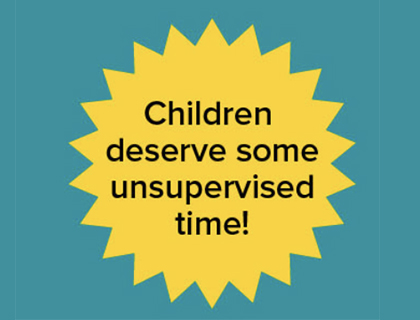Readers — In our desperation to create “smarter” kids, we have practically pinned them to their desks. Now educators are realizing this may be just the opposite of what is best for kids — including those with special needs, as Andrea Gordon writes in Toronto’s TheStar.com (a paper run by my favorite editor-in-chief from back when he and I were at the NY Daily News, Michael Cooke). – L.
It was a crisp March day outside Blaydon Public School when teachers discovered that 4-year-old Alex Wong could spell his name.
There were no pencils or paper in sight. Everyone was bundled in winter jackets. Alex, who has autism, was in the outdoor classroom where his special-needs class played and explored for at least an hour every day, alongside 25 kids from the mainstream kindergarten class.
Teacher Sue Cooper noticed Alex march over to a pile of wood, put three sticks in a small wheelbarrow and push it to a spot on the pavement. One by one, he placed the sticks on the ground, forming the letter A. He made three more trips and came back with sticks to make three more letters, which he placed in a row: L, E and X.
Cooper’s jaw dropped. The teachers ran for a camera.
Alex is non-verbal and for a long time, his only interactions had been to throw things or hit. But in the fresh air, day after day, something started to change. Over several months Alex had watched the other children making structures. And that March morning, he was ready to take his turn.
The teachers say his is one example of how daily outdoor time is changing the way their young students — including those autism and other special needs — learn and behave.
“I’ve never see them come around like this, doing things I didn’t know they were capable of,” says Cooper, a special-education teacher for 20 years.
…
The article goes on to explain that there is a growing “outdoor classroom” movement (I’d dub it the movement movement) in Canada, for which I salute that country! Read the rest of the article here. View the inspiring 90-second video here. And, of course, kick your kids outside while you’re doing this! — L.
An old idea makes sense anew.




21 Comments
Fascinating that some of the most effective nurturing and encouragement are aimed at kids with “special needs,” while the “neurotypical” kids are at the mercy of the whims of faddish parenting.
“Special needs” kids are offered extra opportunities to become self-directed, while the balance of the young population is hovered over and told the world is too dangerous, the disappointments too great.
“Special needs” kids are benefiting from the research, the kind of research that has most of us smacking our foreheads and saying, “DUH!” — Research about playing outdoors, meeting challenges, facing disappointment, and having less emphasis on academics overall.
Here’s an idea: let’s treat all kids equally. They all will benefit from challenges, time outdoors, and facing disappointments.
I am the father of a 7 year old higher functioning Autistic child. We have noticed a pretty strong relationship between how much physical play and/or activity he gets and his behavior.
We live in northern Michigan. And the most difficult times we have with him in terms of behavior are the winter months of January through March. Then as days get longer and outdoor play increases, his mood, behavior and school work blooms as well.
Within the last week I saw Temple Grandin speak locally. She too was emphatic in advocating more vigorous outdoor activity. For ASD in particular, but really for all kids.
I love it. My kids are always wishing their classes would go outside more, although the current school is better about this than the old one. Kids need to move around and play.
More than one special education teacher has told me that their children seem to favor blue light. This made me wonder if some neurologically abnormal children don’t have normal color vision and therefore need more shortwave light. I wonder if there has been any research on this? Incandescent lights and some fluorescent lights are deficient in short wavelengths whereas sunlight is rich is all wavelengths.
As a homeschooler, I often did my work outside. And loved it!
Kids are smarter than society gives them credit for. Why should autistic children be any different?
My son’s school (also in Toronto) is also building an outdoor classroom for the all-day Kindergarten classes that begin this fall.
I hate the idea of all-day Kindergarten. For most students in our school board it means spending most of the day indoors (especially if there’s ANY rain or snow) and not having much time for unstructured play or self-guided learning. I would not have put my boys into an all-day Kindergarten program, especially one that kept them locked up inside all day. I wrote letters against the implementation of the all-day program, but when it happened anyway I was left trying to figure out a way to make it the best experience possible for the students. I became a parent representative on a committee that developed our Outdoor Learning Environment and worked on curriculum that will use the outdoor space on a daily basis for all subjects, not just active play or the occasional nature study.
My sons are already past Kindergarten age, but I hope our new space gives the younger students a chance to be a little more free range while in school. Parents need to put pressure on our school systems to give our children more outdoor (and free range!) opportunities while at school.
T. Doyle–Why stop at kindergarten? Kids of all ages can learn in an outdoor setting, for at least part of the time. You could do nature walks, field trips to swamps/ponds to observe tadpoles turning into frogs, and weedy fields to observe caterpillars turning into butterflies, and to the forest to learn about other kinds of animals, and to count the rings on stumps to determine the age of the trees. Older kids could do plein air drawing and painting for art class, and experiments in physics (paper airplanes, rocketry, etc.), outside. Even lessons that don’t have to be taught outside, still can be. For example, English class could consist of a class of high school students reading Romeo and Juliet in a circle under a tree, or acting out the parts Readers Theatre style, as opposed to sitting inside at their desks reading the same book. If you need access to a blackboard or similar, then a rolling whiteboard, or a small portable whiteboard propped up on a chair or a folding easel, would work just as well. Don’t get me wrong, outdoor kindergarten is a start, but I’m not sure I like the idea of having a big chunk of kindergarten taking place outside, only to switch to a “traditional” indoor, sit-down-and-shut-up format for grade one, because it’d be a rude awakening for a lot of kids, that might turn them off of learning far too early in life.
Emily – I agree that switching to the traditional indoor setting in grade 1 is not a good idea! My son’s school already has many outdoor areas for the older students to use, including an outdoor classroom, vegetable and flower garden, and a naturalized area. The Kindergarten area is an additional project aimed at (but will not be used exclusively by) Kindergarten students, designed for their different curriculum and physical size and gives more space so that more classes can use the outdoor areas at the same time.
I can’t believe it took the educator ( and one who worked with children with a disability) 20 years to figure that one out. Seriously, shouldn’t all educators know that kids learn and make sense of their world, and communicate, through their play. It is sad that everyone sees children with autism or other disabilities through a deficit lens. Play belongs to all children.
Sticks, dirt, sidewalk chalk- all more stimulating than paper and pencil confinement. I can’t believe “daily outdoor time” is newsworthy, but I’m glad it’s helping autistic children learn to communicate.
Charlotte Mason said it more than a hundred years ago: Children learn best from real things in the real world. Children must begin by exercising their bodies and senses, preferably outdoors where sensory and motor opportunities are without limit. Then they can work with concrete objects, moving gradually to abstractions, as their brains mature.
She also argued–using 19th-century metaphors, of course–that a child’s mind is not a game of Tetris that requires a teacher’s careful hand on the controls. Children presented with the context can isolate and synthesize the data on their own. Example: Alex!
It is a crying shame that after 20 years in the field, this educator is surprised by this! But that is the educational climate we have. Charlotte Mason’s outlook did not become the mainstream, unfortunately.
As a nursery nurse over 40 years ago we were told that most learning for under 7s should be through play and exploration. No reason why it shouldn’t carry on after this.
I just got back from a short trip to Japan, and one of the most striking things we noticed (especially in light of how much we hear about their rigid schools), is that there were school children everywhere, at all hours of the day. They were in uniform, usually in small groups. I don’t know what they were doing, but at least they were getting some time away from school. We did ask one elementary-age kid what time he went to school, and he said 11-4. I sure wish my kids could do that. BTW, they were all over the public transportation, and of course knew how to handle it and how to behave.
Simply amazing that we have built such a bizarre construct where kids playing outside is a bold, new idea.
CLamb – Temple Grandin talks about the impact of colors, and the related research, in The Autistic Brain.
To add to the international perspective…
My primary school was&is from 8.45 to 12.15 (including a short break around 10.15 to eat a little something, and a ‘outside play break’ of which I don’t remember how long it was, just that it was long enough for this bookwurm to take my book with me and read outside in the sun…) and then from 13.15 to 15.15 (afternoon off on Wednesday).
The 4- and 5-year-olds get PE both in the mornings and the afternoons, outside if possible, inside if necessary (I presume this is on top of the normal playbreak the older kids get too, otherwise they wouldn’t get the legally required ‘break from learning’, unless the lunchbreak counts as break from learning too….?).
I love it! Play is an important part of learning. This will someday become common knowledge.
In Germany they have “Waldkindergarten” (forest pre-schools) which spend nearly all day outside, wandering in the woods– only going inside in the worst weather.
Well shoving kids outside doesn’t always make them smarter. Just look at Asia, whose kids are at the top tier if intellect and education and they do not AT ALL focus in outdoor play. And then in the U.S., here are people saying that kids should play outside trying to become smarter like their Asian counter mates.
great think .i love it